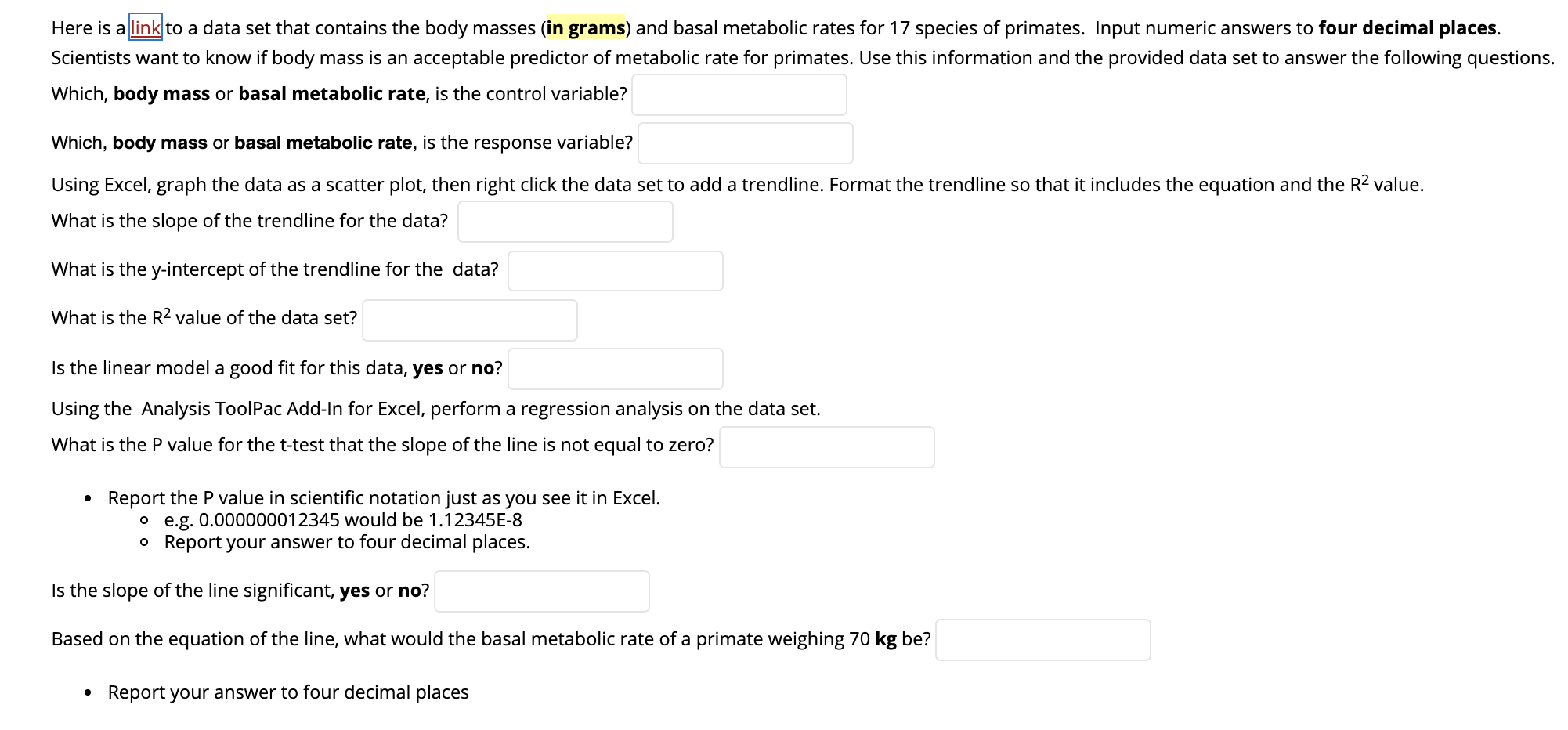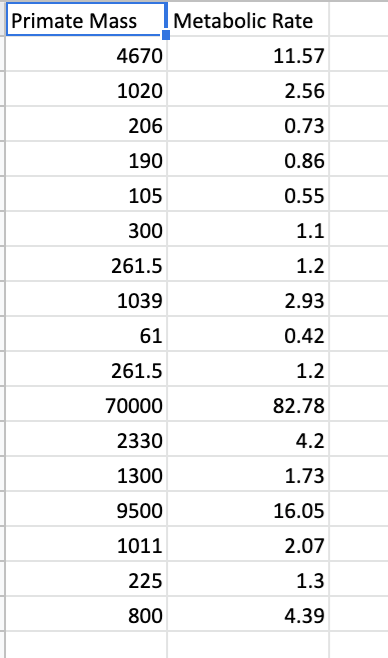Here is a link to a data set that contains the body masses (in grams) and basal metabolic rates for 17 species of primates. Input numeric answers to four decimal places. Scientists want to know if body mass is an acceptable predictor of metabolic rate for primates. Use this information and the provided data set to answer the following questions. Which, body mass or basal metabolic rate, is the control variable? Which, body mass or basal metabolic rate, is the response variable? Using Excel, graph the data as a scatter plot, then right click the data set to add a trendline. Format the trendline so that it includes the equation and the R2 value. What is the slope of the trendline for the data? What is the y-intercept of the trendline for the data? What is the R2 value of the data set? Is the linear model a good fit for this data, yes or no? Using the Analysis ToolPac Add-In for Excel, perform a regression analysis on the data set. What is the P value for the t-test that the slope of the line is not equal to zero? Report the P value in scientific notation just as you see it in Excel. o e.g. 0.000000012345 would be 1.12345E-8 o Report your answer to four decimal places. Is the slope of the line significant, yes or no? Based on the equation of the line, what would the basal metabolic rate of a primate weighing 70 kg be? • Report your answer to four decimal places Primate Mass Metabolic Rate 4670 11.57 1020 2.56 206 0.73 190 0.86 105 0.55 300 1.1 261.5 1.2 1039 2.93 61 0.42 261.5 1.2 70000 82.78 2330 4.2 1300 1.73 9500 16.05 1011 2.07 225 1.3 800 4.39
Here is a link to a data set that contains the body masses (in grams) and basal metabolic rates for 17 species of primates. Input numeric answers to four decimal places. Scientists want to know if body mass is an acceptable predictor of metabolic rate for primates. Use this information and the provided data set to answer the following questions. Which, body mass or basal metabolic rate, is the control variable? Which, body mass or basal metabolic rate, is the response variable? Using Excel, graph the data as a scatter plot, then right click the data set to add a trendline. Format the trendline so that it includes the equation and the R2 value. What is the slope of the trendline for the data? What is the y-intercept of the trendline for the data? What is the R2 value of the data set? Is the linear model a good fit for this data, yes or no? Using the Analysis ToolPac Add-In for Excel, perform a regression analysis on the data set. What is the P value for the t-test that the slope of the line is not equal to zero? Report the P value in scientific notation just as you see it in Excel. o e.g. 0.000000012345 would be 1.12345E-8 o Report your answer to four decimal places. Is the slope of the line significant, yes or no? Based on the equation of the line, what would the basal metabolic rate of a primate weighing 70 kg be? • Report your answer to four decimal places Primate Mass Metabolic Rate 4670 11.57 1020 2.56 206 0.73 190 0.86 105 0.55 300 1.1 261.5 1.2 1039 2.93 61 0.42 261.5 1.2 70000 82.78 2330 4.2 1300 1.73 9500 16.05 1011 2.07 225 1.3 800 4.39
Glencoe Algebra 1, Student Edition, 9780079039897, 0079039898, 2018
18th Edition
ISBN:9780079039897
Author:Carter
Publisher:Carter
Chapter10: Statistics
Section10.6: Summarizing Categorical Data
Problem 23PPS
Related questions
Question
100%
please highlight the correct answer

Transcribed Image Text:Here is a link to a data set that contains the body masses (in grams) and basal metabolic rates for 17 species of primates. Input numeric answers to four decimal places.
Scientists want to know if body mass is an acceptable predictor of metabolic rate for primates. Use this information and the provided data set to answer the following questions.
Which, body mass or basal metabolic rate, is the control variable?
Which, body mass or basal metabolic rate, is the
response variable?
Using Excel, graph the data as a scatter plot, then right click the data set to add a trendline. Format the trendline so that it includes the equation and the R2 value.
What is the slope of the trendline for the data?
What is the y-intercept of the trendline for the data?
What is the R2 value of the data set?
Is the linear model a good fit for this data, yes or no?
Using the Analysis ToolPac Add-In for Excel, perform a regression analysis on the data set.
What is the P value for the t-test that the slope of the line is not equal to zero?
Report the P value in scientific notation just as you see it in Excel.
o e.g. 0.000000012345 would be 1.12345E-8
o Report your answer to four decimal places.
Is the slope of the line significant, yes or no?
Based on the equation of the line, what would the basal metabolic rate of a primate weighing 70 kg be?
• Report your answer to four decimal places

Transcribed Image Text:Primate Mass
Metabolic Rate
4670
11.57
1020
2.56
206
0.73
190
0.86
105
0.55
300
1.1
261.5
1.2
1039
2.93
61
0.42
261.5
1.2
70000
82.78
2330
4.2
1300
1.73
9500
16.05
1011
2.07
225
1.3
800
4.39
Expert Solution
This question has been solved!
Explore an expertly crafted, step-by-step solution for a thorough understanding of key concepts.
This is a popular solution!
Trending now
This is a popular solution!
Step by step
Solved in 4 steps with 3 images

Knowledge Booster
Learn more about
Need a deep-dive on the concept behind this application? Look no further. Learn more about this topic, statistics and related others by exploring similar questions and additional content below.Recommended textbooks for you

Glencoe Algebra 1, Student Edition, 9780079039897…
Algebra
ISBN:
9780079039897
Author:
Carter
Publisher:
McGraw Hill

Linear Algebra: A Modern Introduction
Algebra
ISBN:
9781285463247
Author:
David Poole
Publisher:
Cengage Learning

Functions and Change: A Modeling Approach to Coll…
Algebra
ISBN:
9781337111348
Author:
Bruce Crauder, Benny Evans, Alan Noell
Publisher:
Cengage Learning

Glencoe Algebra 1, Student Edition, 9780079039897…
Algebra
ISBN:
9780079039897
Author:
Carter
Publisher:
McGraw Hill

Linear Algebra: A Modern Introduction
Algebra
ISBN:
9781285463247
Author:
David Poole
Publisher:
Cengage Learning

Functions and Change: A Modeling Approach to Coll…
Algebra
ISBN:
9781337111348
Author:
Bruce Crauder, Benny Evans, Alan Noell
Publisher:
Cengage Learning

Big Ideas Math A Bridge To Success Algebra 1: Stu…
Algebra
ISBN:
9781680331141
Author:
HOUGHTON MIFFLIN HARCOURT
Publisher:
Houghton Mifflin Harcourt